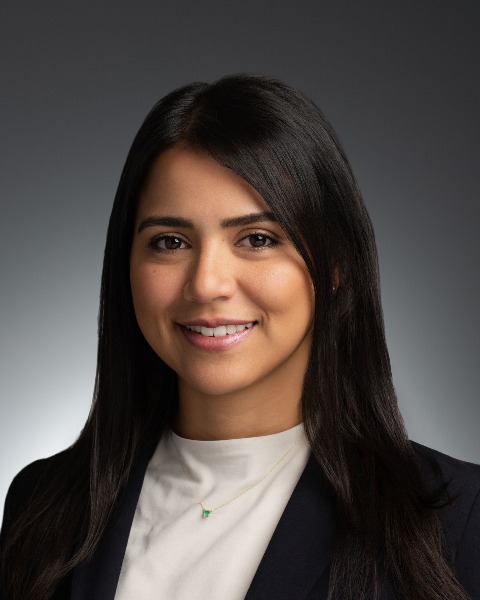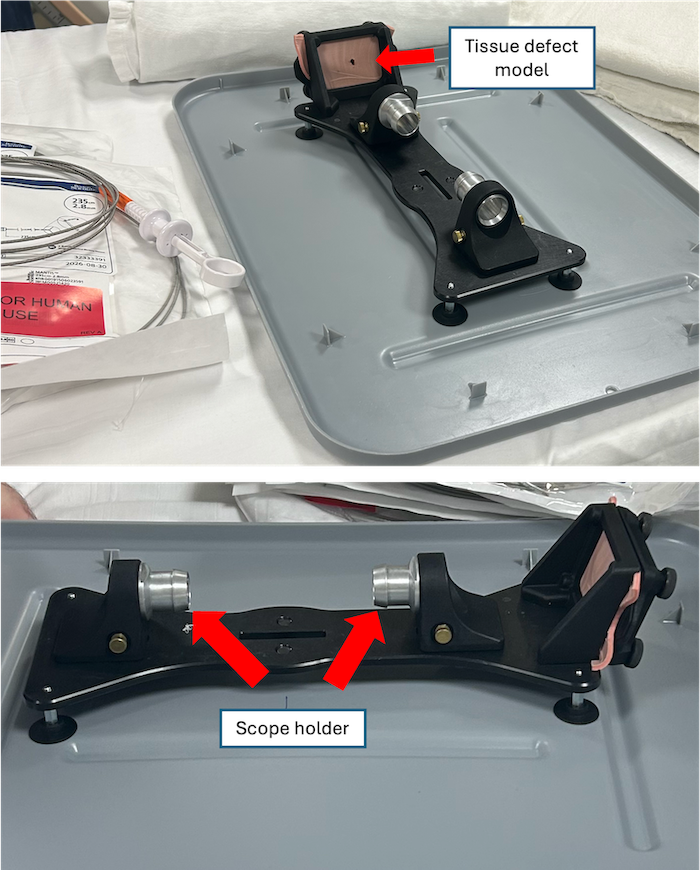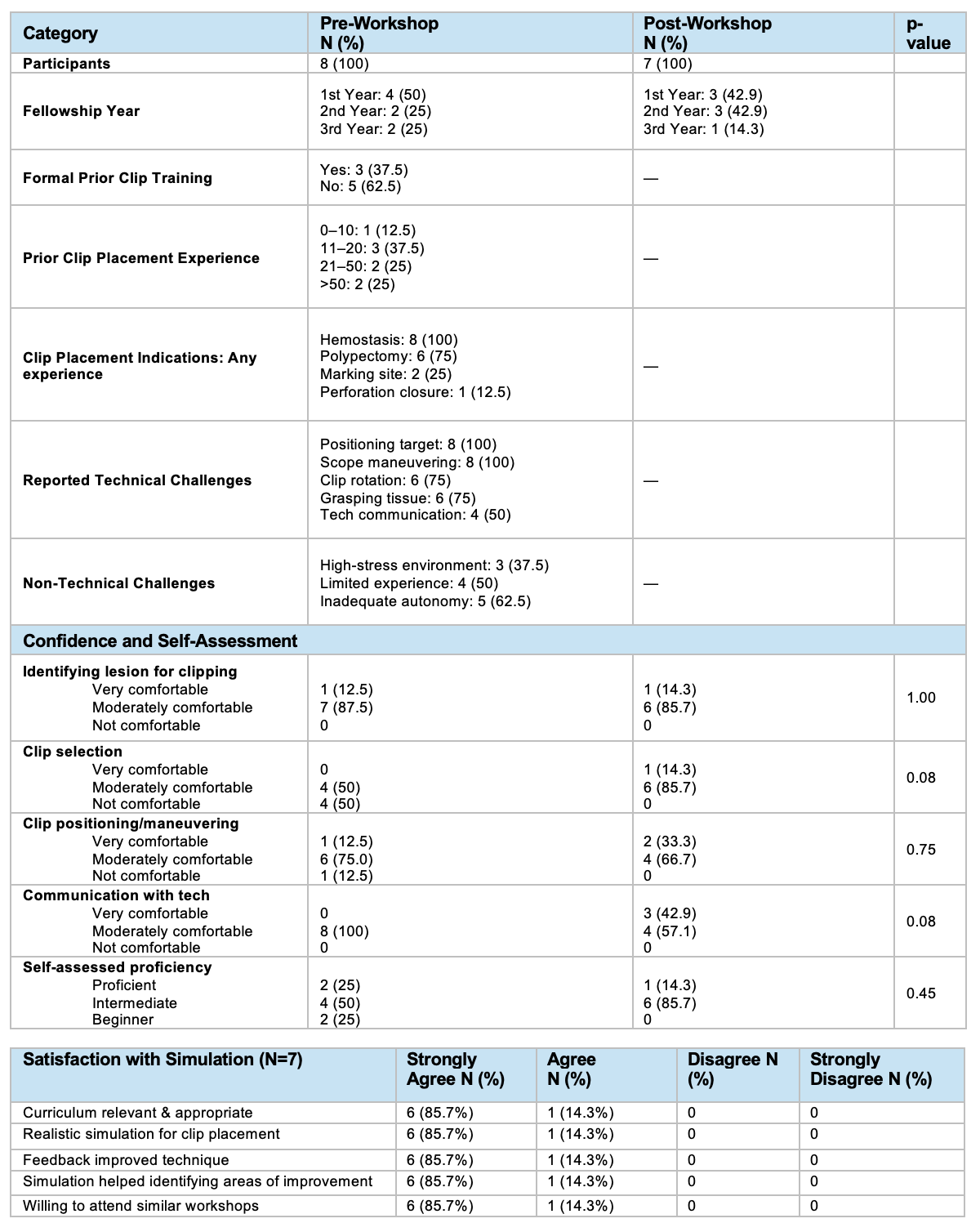Sunday Poster Session
Category: General Endoscopy
P0848 - Enhancing Gastroenterology Fellow Competency in Through-the-Scope Clip Placement: A Simulation-Based Approach
Sunday, October 26, 2025
3:30 PM - 7:00 PM PDT
Location: Exhibit Hall

Jellyana Peraza, MD (she/her/hers)
Icahn School of Medicine at Mount Sinai
New York, NY
Presenting Author(s)
Jellyana Peraza, MD, Nicholas Hoerter, MD, Kamron Pourmand, MD, Brijen Shah, MD, Satish Nagula, MD
Icahn School of Medicine at Mount Sinai, New York, NY
Introduction: Simulation-based education in GI endoscopy improves procedural performance and patient safety. Despite the widespread use of through-the-scope (TTS) clips, GI fellows often learn clip placement informally or on ex-vivo models without direct clinical relevance. We developed and evaluated a simulation-based curriculum to improve GI fellows’ competency in TTS clip placement.
Methods: We designed a 1.5-hour hands-on workshop for first- through third-year GI fellows at a high-volume academic center. The curriculum included (1) a baseline skills assessment where fellows placed a TTS clip on a linear defect cut into a synthetic tissue model mounted on a scope-holder device (Boston Scientific “Suture Stand”; Figure 1); (2) a 20-minute workshop covering clip characteristics, placement techniques, troubleshooting, and videos of optimal and suboptimal placements; and (3) a guided practice session on a complex simulated defect requiring multiple clips, with real-time faculty feedback. Pre- and post-intervention surveys administered at different dates assessed confidence, attitudes, and satisfaction. Fisher exact test compared survey responses.
Results: Eight fellows participated; 37.5% had prior formal clip training from regional conferences. Most (75%) had performed 11–50 clip procedures, most common indications included hemostasis (100%) and polypectomy defect closure (75%). Pre-workshop challenges included positioning the target lesion (100%), limited scope maneuverability (100%), clip rotation/positioning (75%), and tissue grasping (75%). Post-intervention, confidence and self-assessed proficiency improved across all domains: comfort with clip selection increased from 50% to 100% (p=0.08); clip positioning/maneuvering from 87.5% to 100% (p=0.75); and "intermediate" proficiency rose from 50% to 85.7% (p=0.45). Fellows rated the curriculum as relevant, realistic, and valuable, with 100% willing to participate in future simulation workshops (Table 1).
Discussion: This pilot study demonstrates that a simulation-based curriculum for TTS clip placement is feasible, effective, and well-received by GI fellows. Integration of such training into fellowship programs can enhance procedural skills, and further studies are needed to assess long-term impact on clinical performance.

Figure: Table 1. Summary of Baseline Characteristics, Prior Experience, Confidence, and Satisfaction with TTS Clip Simulation Curriculum

Figure: Figure 1: Simulation Model for Through-the-Scope Clip Placement: This setup allows trainees to practice clip placement technique in a controlled, realistic environment
Disclosures:
Jellyana Peraza indicated no relevant financial relationships.
Nicholas Hoerter: Amgen – Advisory Committee/Board Member. Redesign Health – Stock Options.
Kamron Pourmand indicated no relevant financial relationships.
Brijen Shah indicated no relevant financial relationships.
Satish Nagula indicated no relevant financial relationships.
Jellyana Peraza, MD, Nicholas Hoerter, MD, Kamron Pourmand, MD, Brijen Shah, MD, Satish Nagula, MD. P0848 - Enhancing Gastroenterology Fellow Competency in Through-the-Scope Clip Placement: A Simulation-Based Approach, ACG 2025 Annual Scientific Meeting Abstracts. Phoenix, AZ: American College of Gastroenterology.
Icahn School of Medicine at Mount Sinai, New York, NY
Introduction: Simulation-based education in GI endoscopy improves procedural performance and patient safety. Despite the widespread use of through-the-scope (TTS) clips, GI fellows often learn clip placement informally or on ex-vivo models without direct clinical relevance. We developed and evaluated a simulation-based curriculum to improve GI fellows’ competency in TTS clip placement.
Methods: We designed a 1.5-hour hands-on workshop for first- through third-year GI fellows at a high-volume academic center. The curriculum included (1) a baseline skills assessment where fellows placed a TTS clip on a linear defect cut into a synthetic tissue model mounted on a scope-holder device (Boston Scientific “Suture Stand”; Figure 1); (2) a 20-minute workshop covering clip characteristics, placement techniques, troubleshooting, and videos of optimal and suboptimal placements; and (3) a guided practice session on a complex simulated defect requiring multiple clips, with real-time faculty feedback. Pre- and post-intervention surveys administered at different dates assessed confidence, attitudes, and satisfaction. Fisher exact test compared survey responses.
Results: Eight fellows participated; 37.5% had prior formal clip training from regional conferences. Most (75%) had performed 11–50 clip procedures, most common indications included hemostasis (100%) and polypectomy defect closure (75%). Pre-workshop challenges included positioning the target lesion (100%), limited scope maneuverability (100%), clip rotation/positioning (75%), and tissue grasping (75%). Post-intervention, confidence and self-assessed proficiency improved across all domains: comfort with clip selection increased from 50% to 100% (p=0.08); clip positioning/maneuvering from 87.5% to 100% (p=0.75); and "intermediate" proficiency rose from 50% to 85.7% (p=0.45). Fellows rated the curriculum as relevant, realistic, and valuable, with 100% willing to participate in future simulation workshops (Table 1).
Discussion: This pilot study demonstrates that a simulation-based curriculum for TTS clip placement is feasible, effective, and well-received by GI fellows. Integration of such training into fellowship programs can enhance procedural skills, and further studies are needed to assess long-term impact on clinical performance.

Figure: Table 1. Summary of Baseline Characteristics, Prior Experience, Confidence, and Satisfaction with TTS Clip Simulation Curriculum

Figure: Figure 1: Simulation Model for Through-the-Scope Clip Placement: This setup allows trainees to practice clip placement technique in a controlled, realistic environment
Disclosures:
Jellyana Peraza indicated no relevant financial relationships.
Nicholas Hoerter: Amgen – Advisory Committee/Board Member. Redesign Health – Stock Options.
Kamron Pourmand indicated no relevant financial relationships.
Brijen Shah indicated no relevant financial relationships.
Satish Nagula indicated no relevant financial relationships.
Jellyana Peraza, MD, Nicholas Hoerter, MD, Kamron Pourmand, MD, Brijen Shah, MD, Satish Nagula, MD. P0848 - Enhancing Gastroenterology Fellow Competency in Through-the-Scope Clip Placement: A Simulation-Based Approach, ACG 2025 Annual Scientific Meeting Abstracts. Phoenix, AZ: American College of Gastroenterology.
